biotop auersthal
VIDEO Biotop Auersthal , VIDEO Kellergasse "Wunderberg" Auersthal , VIDEO Kellergasse "Maulavern" Zellerndorf .
The pond ‘Biotop’ (48°22’50.9''N,
16°37’27.3''E)
belongs to the wine-making
village Auersthal. It is located at 160 m above
sea
level
in
the Weinviertel
district in Lower Austria,
about 30 km distant
from the
centre of the capital Vienna. The
pond
comprises two water basins. The main basin has an area of
2400 m2 and a maximum depth
of about
1 m. The second basin is much shallower and smaller, of
350 m2
only. The two basins are connected. The pond
is
embedded in a small woodland.
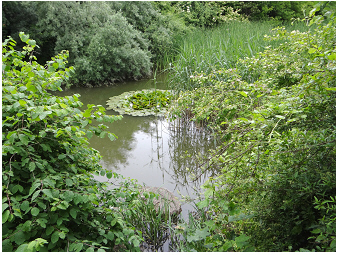 Pond 'Biotop' in Auersthal,
2013:
Pond 'Biotop' in Auersthal,
2013:
The smaller water basin of the pond that is mainly covered by water
plants.
VIDEO Biotop Auersthal, 2022:
Small wetland hotspots, such as ponds, increase the structural landscape diversity
and thus form ecologically important habitats for many animals, such as frogs.
"Each village has its own pond created as a biotope!"
is a valuable contribution
to enhanced biodiversity in urban areas. Small biotopes that are not too far distant
build a network connecting these habitats. Short distances ensure a stable exchange
of birds, small mammals, amphibians, and insects between these hotspot habitats.
Such pond, however, is also valuable for local people - it is
"nature in close neighborhood that has remained touchable in
urban settlement" -
in many ways this biotope is a local place of urban childhood adventure of exploring
nature "in muddy boots".
Even the pond was in the past and is still at
present a man-made water basin, but it's character has changed
with time. The pond was originally used as a reservoir for flood
control (Büchler 2003 R
and Büchler 2005 R)
and hence was a temporary water basin only, to
retain and to
store the water after heavy rain protecting the farmland and the
housing area
in the village Auersthal. At that time, the basin was embedded in
riparian softwood-land. The wood was mainly built by stands of Populus
indicating the relic of an earlier flood plain with a streambed. This
former stream, named 'Mühlbach', was flowing through the wood ‘Hochleithenwald’
and was then
entering the area of meadows, farmland and vineyards of Auersthal.
The pond habitat has much changed in the past decade, when volunteers of
Auersthal initiated the project named 'Biotop Auersthal' to design
this pond area. The pond was very close to an indoor swimming
pool that was opened in 1971 ("Europa-Bad",
) and
the settlement
Badsiedlung (Europabadsiedlung)’
that was founded at that the same time. With a twinkle in their eyes,
local
people sometimes
even call this settlement
‘Gimpel-Siedlung’ acknowledging the many
woodland birds as ‘Gimpel’ (Chaffinch, Fringilla
coelebs) that are regularly visiting this housing area
edging the ‘Biotop’ and that is
not far from further woodland in Auersthal ('Gemeindewald'). Meanwhile,
the indoor swimming pool has been removed but the
settlement has even grown in this area of the wine-making village.
Project ‘Biotop Auersthal’
was in part financially supported by a local government initiative
through the foundation ‘Dorf-Erneuerungs-Verein’
(DEV, Büchler 2003
R
and Büchler 2005 R
). The aim of this
charity association can be described as to ‘upgrade the life in
villages – keep good old traditions alive in the modern life style’. It
was the successor of the charity association
‘Verschönerungs-Verein’,
a common volunteer initiative in Austria
simply saying ‘make our villages and towns look more beautiful’. The
aim of the project ‘Biotop Auersthal’ was to re-design the pond as an area
of higher recreational value. The natural rural-riparian woodland was
replaced by planting a large variety of trees, bushes and shrubs, which
are common in the Pannonian plain and were available by local market
gardens (Büchler 2003 R
).
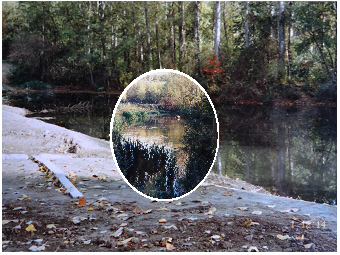 Pond 'Biotop' in Auersthal, 2000:
Pond 'Biotop' in Auersthal, 2000:
The main water basin of the pond ’Biotop Auersthal’ shown before the
project started in 2001.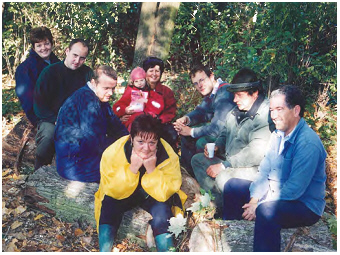 Pond 'Biotop' in Auersthal,
2001:
Pond 'Biotop' in Auersthal,
2001:
Volunteers of the charity
association ’Dorf-Erneuerungs-Verein’ were involved in the planning and
implementation of the project ‘Biotop Auersthal’.
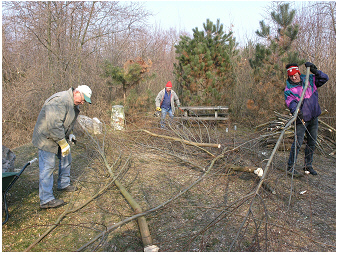 Pond 'Biotop' in Auersthal, 2011:
Pond 'Biotop' in Auersthal, 2011:
Volunteers are twice a year maintaining the trails going through the
wood around the pond ‘Biotop Auersthal’. Some of them
were involved in the project right from the start, contributed
their
expertise and carried out the project work.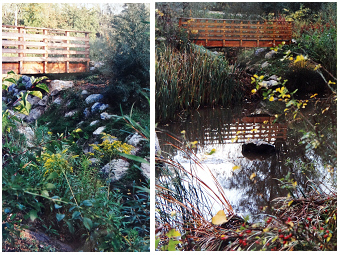 Pond 'Biotop' in Auersthal,
2003/2004:
Pond 'Biotop' in Auersthal,
2003/2004:
Short wooden bridge over the watercourse connecting both water basins.
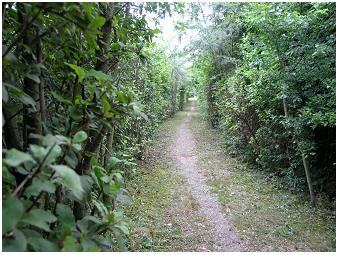 Pond 'Biotop' in Auersthal, 2010:
Pond 'Biotop' in Auersthal, 2010:
Trail in the wood ’Biotop Auersthal’: About 3500 trees and shrubs were
planted in this artificial pond-wood area ten years ago, in 2001.
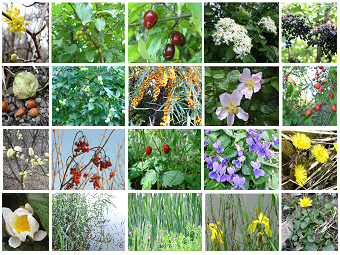 Plants found in 'Biotop
Auersthal', 2009-2015:
Plants found in 'Biotop
Auersthal', 2009-2015:
From left to right, line 1 to 4: Cornelian Dogwood - flowers, unripe and ripe fruits
(Cornus mas); Elder - flowers and fruits ( Sambucus nigra); European Bladdernut - fruit and bough
(Staphylea pinnata); Common Sea-Buckthorn (Hippophae rhamnoides); Dog-rose - flowers and fruits
rosehips (Rosa canina); Willow (Salix spec);
Guelder-Rose (Viburnum opulus); Wild strawberry
/(Fragaria vesca ); Violet (Viola spec.); Coltsfoot (Tussilago farfara; White water lily (Nymphaea alba); Common reed (Phragmites australis); Great Willow Herb (Epilobium hirsutum) and Bulrush (Typha latifolia); Yellow Iris (Iris pseudacorus) and Hard Rush (Juncus inflexus); Lesser Celandine (Ranunculus ficaria).
As described in a more detail in the section about the birds seen in
the ‘Biotop Auersthal’ (see text and bird species list by Kerschbaumer, the
large variety of berries and other fruits from shrubs,
bushes and
trees (e.g. wild apple tree) certainly
attracted the singing birds
(see photos about shrubs, bushes and birds in the gallery and the summary photo about
„plants found in ‘Biotop Auersthal’“
in the text; see also Büchler 2003 R
and DEV 2016 folder
R
).
According to the records by Kerschbaumer,
an increasing diversity of birds has been observed recently with building up the
biotope. It thus agrees that diverse landscape structure (pond plus reed belt plus wood =
'Biotop Auersthal')
can enhance the number of species in habitats. The number bird species observed over 12
years can be seen
as a reference for biodiversity of birds in 'Biotop Auersthal'.
The change over time in view of the number of birds per
bird species
(number of individuals), i.e., whether the number of individuals of
songbirds has remained stable or has increased or decreased over the years is not shown
here.
To show up what the trends are would mean to count how many blue tits, how many sparrows,
how many hoopoes,
etc. are in the 'Biotop' every second or every five years.
Such investigations are carried out in some habitats (bird watching, bird surveys, bird
ringing, see e.g.,
Biological Station Neusiedlersee Illmitz or National Park Neusiedlersee-Seewinkel),
to see how the birds are going on globally. That kind of investigations are important
measure environmental change
but require in case of birds a
larger team of 'bird watching people', and are therefore rarely undertaken and usually done
in particular habitats only.
It is therefore very valuable when somebody like Ottmar Kerschbaumer regularly notes the
bird species
that live in a habitat like the 'Biotop Auersthal'. His notes are invaluable information
about the
birds in the biotope that we would not otherwise have and would indeed miss.
The same as for
birds could
be surveyed for other animals and plants in the 'Biotop', such as insects (e.g.,
butterflies), earth worms, gastropods,
arthropods, amphibians (e.g., frogs), fishes, mammals, mushrooms, trees, bushes, and other
herb plants, as well as tiny organisms observed
under a microscope in a drop of pond water (e.g., algae and microscopic animals, see e.g., Teubner 2001, Wetzel 2001).
All these many animals and plants live densely together in such an environment and thus
finally make up a living space of terrestrial and aquatic
ecosystems as it is in case of 'Biotop Auersthal'.
Otmar Kerschbaumer, who regularly surveyed birds in the biotope Auersthal,
recorded 6 waterfowl species, with Little grebe (Tachybaptus
ruficollis),
Common moorhen (Gallinula
chloropus) and the Common kingfisher (Alcedo atthis)
being particularly worth mentioning here. Of the 5 species of birds of prey in open sparse
deciduous stands,
the Tawny owl (Strix
aluco) and the Gyrfalcon (Falco rusticolus) deserve special mention.
Of the two species of meadows and forest fringes, reference should be made to the Grey partridge (Perdix perdix).
The diverse number of remaining 43 bird species recorded by Kerschbaumer in the biotope is
particularly high
and refers mainly to songbirds. Here the Eurasian hoopoe
(Upupa epops), Eurasian golden oriole (Oriolus oriolus),
and European bee-eaters (Merops
apiaster) are named as thermophilic species. Also included are the
Common nightingale (Luscinia
megarhynchos), Goldcrest (Regulus regulus),
Eurasian wren (Troglodytes
troglodytes),
European robin (Erithacus
rubecula), Eurasian blue tit (Cyanistes caeruleus), European serin (Serinus serinus),
Yellowhammer (Emberiza citrinella), Hawfinch (Coccothraustes
coccothraustes), European goldfinch (Carduelis carduelis),
Eurasian blackcap (Sylvia atricapilla), White wagtail (Motacilla alba),
Common cuckoo (Cuculus
canorus)
as well as Eurasian treecreeper (Certhia familiaris), Eurasian jay (Garrulus glandarius)
and Common blackbird (Turdus
merula).
The complete list by Kerschbaumer of a total of 56 bird species observed in the Auersthal
biotope is available here:
R
,
see also Büchler 2005 R.
Some of these mentioned bird species can be seen in the photo gallery at the top of this
page.
In addition to the bird species list by Kerschbaumer, Gray heron (Ardea cinerea) and
Common starling (Sturnus
vulgaris)
are further two bird species observed at floodplain pond 'biotop Auersthal'.
Of the 58 bird species in total, the heron, wren, tree sparrow, yellowhammer, house sparrow,
goldfinch, black redstart,
great tit, blackbird, and starling are shown in the photo in the
DEV 2016 folder
R
.
Other animals from the biotope that are not birds are
the Scorpion fly (Panorpa
communis),
the Green rose chafer (Cetonia
aurata),
the Leopard slug (Limax
maximus),
the Violet oil beetle (Meloë
violaceus),
the Common water frog (Pelophylax
kl. esculentus),
the European toad (Bufo
bufo),
the Northern white-breasted hedgehog (Erinaceus roumanicus),
the European hare (Lepus
europaeus) and
the Grass snake (Natrix
natrix) are presented in the photo. Among the plants are
Willow (Salix spec.),
European bladdernut (Staphylea
pinnata),
Guelder-rose (Viburnum opulus),
Cornelian cherry (Cornus
mas),
Sea-buckthorn (Hippophae rhamnoides),
European elderberry (Sambucus nigra),
Dog rose (Rosa canina),
the Wild strawberry (Fragaria vesca),
the Coltsfoot (Tussilago
farfara) and
the Violet (Viola spec.). The DEV folder also contains animal
and plant puzzles about the biotope
R
.
As could be shown by birds and other animals and plants, that inhabit this artificial pond,
for example,
the 'Biotop Auersthal' is of great value as an aquatic habitat
for wild life.
With global warming and thus more frequent drying out scenarios, however,
small ponds and wet-lands belong to most threatened
habitats in the wine-making region around Auersthal.
About 50-100 years ago, before the pit of the later pond was used for flood control, mud was taken from the site of the main basin to make bricks. These bricks were called ‘Kot-Ziegel’ (mud bricks, the local word for mud is ‘Kot’) and were of low quality only when compared with the commonly produced bricks made from loam-clay material in this region. During the period from 1850 to 1950, local brick manufacturing was quite common in this region and for example, the village Auersthal had up to five small brick yards at that time. The surface-clay bricks were processed by forming and drying, and those of high quality were even further treated by firing. Individual labels were marked on the surface of the bricks during manufacturing and indicate until these days from what local brick yard in or nearby Auersthal the bricks of an old house originate. The plentiful brick labels give a further signature for the many loam-clay digging sites (brick yards) in this area at that earlier time, even if only a few of these sites ended up as a pond today as described here for the ‘Biotop Auersthal’. Another example of valuable man-made ecosystem is the loam pit pond of the brickyard Schönkirchen nearby Auerstal (for gravel pit lake/gravel pit pond 'Kiessee' see shallow urban lakes Gr Mueggelsee S and Naturally designed Wildlife and swimming ponds S).
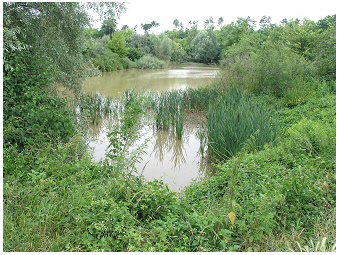 Pond 'Biotop' in Auersthal, 2010:
Pond 'Biotop' in Auersthal, 2010:
Main basin of the biotop seen along the longitudinal extension. 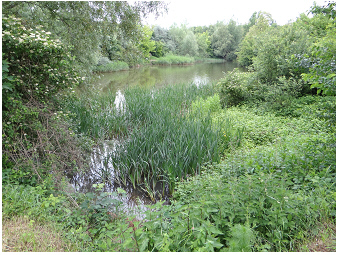 Pond 'Biotop' in Auersthal, 2013:
Pond 'Biotop' in Auersthal, 2013:
View as the left photo but three years later with more dense stands of
water plants. In the foreground seen are mainly stands of
Broadleaf Cattail, Bulrush (Typha latifolia,
used as 'Binderrohr" for sealing the doors of wooden barrels for wine-making in
Auersthal).
This plant grows well in nutrient-rich shallow waters.
The water in the main basin is quite well retained due to the fine grain size of further brick-yard-material on the bottom of the basin. The volunteers monitor and maintain a certain water level here and thus at least the main basin can be now characterized as permanent stagnant water. The pit of the small basin, however, looks different. It was mainly the result of the removal of the humus layer used as soil for fields and gardening. The ground layer of the small basin might be of rather coarse material, and hence it dries out from time to time, in particular, in years of low precipitation (see photo 4 in the gallery on top). The maintenance of a certain water level in the pond today becomes even more difficult as the ground water level in this region is now much lower than it was decades ago and perhaps might decrease further.
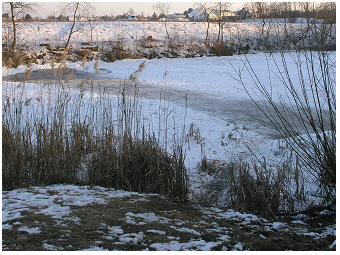 Pond 'Biotop' in Auersthal, 2009:
Pond 'Biotop' in Auersthal, 2009:
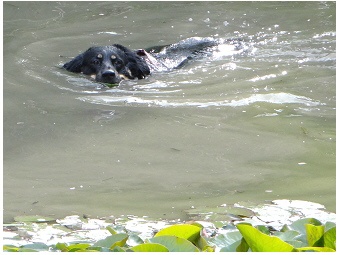 Pond 'Biotop' in Auersthal,
2013:
Pond 'Biotop' in Auersthal,
2013:
‘Biotop Auersthal’ is now a popular place for the local people. You can meet here people of all ages. People are having a chat while walking through the wood or coming to have a rest, doing exercises, biking or letting their dogs go swimming. Some young kids are coming with their fishing rods! Whatever people might expect to enjoy most here: The ‘Biotop’ is certainly a place for getting in touch with nature.
VIDEO Cellar lane 'Wunderberg'
Auersthal, 2018:
1: tree press as an exhibit;
2: wine picking on the gust;
3: Cellar saying "Up the noble grape juice, it gives people courage and strength";
4: Pouring freshly lifted, unfiltered wine;
5: Barrels are regularly brushed;
6: Bottle washing, including grapes in the basket that have been carefully stored
until Advent;
7: Wine scale for density measurement (grape juice sweetness);
8: Candle for detecting potential cellar gas, binder tube = Typha/Bulrush for
sealing wine barrel doors, filtering and bottling wine;
9: wine bottles in stock;
10: lively village festival atmosphere on the Wunderberg.
VIDEO Cellar lane 'Maulavern' in the
wine-making village Zellerndorf, Weinviertel, 2023:
Cellar lanes remind us today in particular of the earlier traditional wine-growing
culture.
Not every but many cellar lanes were preserved in the Weinviertel.
The 'Maulavern Kellergasse' is a cellar lane of particularly high cultural value and
is therefore also well worth seeing - many reasons to enjoy the place!
Looking back, it can be said that the step-by-step development
of the Auersthal biotope, from a clay pit to a valuable new hot-spot habitat for
nature,
was historically closely linked to the continuation of the traditional way of life, but also
to an open-mindedness towards today's life in the wine village.
At earlier time clay and water were valuable goods (resources) that were used sparingly.
The cellar lanes without water connection and other
living comforts were only used for protecting people during making wine, to process wine.
Cleaning wooden barrels after emptying the wine was done with just one or two buckets of
water.
The cellar lanes are thus relicts from that traditional and also
generally careful management and resource-saving life.
This way, the clay-pit had traditionally been used in the village for decades.
Later on, the gravel-pit was somehow seen as a lost place where to put some village garbage
in.
With today's understanding of flood protection and the
preservation of nature,
an artificial but valuable pond habitat was created with the 'Biotop Auersthal'.
The Heritage Museum in the wine-making
village Grossengersdorf (NÖ Museum für Dorfkultur in Großengersdorf)
provides insights in traditional
everyday
life and also wine culture (Moser 1952) in this wine-making region of
Lower Austria. Großengersdorf
is located in close proximity to the wine
village Auersthal.
DEV 2016. Unser Biotop in Auersthal - Pflanzen, Vögel und weitere Tiere. In German about our pond in Auersthal: Plants, birds and other animals. Folder . Look-Inside
Harding, J. 2006. Austria. In: The Oxford Companion to Wine. 49-54. 3rd edition. Oxford University Press, New York.
Büchler, I. 2005. Das Biotop – ein Paradies für Vögel. ‘s Dorfblattl - Mitteilungen des Auersthaler Dorferneuerungsvereins „Leben im Dorf“, 2: page 3. Look-Inside
Büchler, I. 2003. Projekt Biotop. ‘s Dorfblattl - Mitteilungen des Auersthaler Dorferneuerungsvereins „Leben im Dorf“, 1: pages 4-5. Look-Inside
Teubner, K. 2001. Algengemeinschaften in Seen. 83-112. In: Ökologie und Schutz von Seen. UTB Facultas, Wien. Look-Inside
Teubner, K. 2023. Liste der beobachteten Vogelarten von Otmar Kerschbaumer (Beobachtungszeitraum 2001 bis 2012). (List of Birds, observed at Biotop Auersthal (2001-2012) by Otmar Kerschbaumer). Look-Inside
Wetzel, R. 2001. Shallow lakes and ponds. 625–630. In: Limnology: Lake and River Ecosystems. 3rd edition. Academic Press, San Diego, London. FurtherLink
Moser, L. 1952. Weinbau einmal anders: Ein Weinbaubuch für den fortgeschrittenen Weinbauer. 3rd edition. Self-publishing, Rohrendorf bei Krems an der Donau.